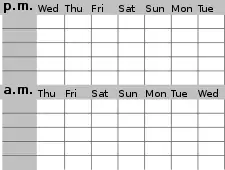Sleep diary
A sleep diary is a record of an individual's sleeping and waking times with related information, usually over a period of several weeks. It is self-reported or can be recorded by a care-giver.

The sleep diary, or sleep log, is a tool used by doctors and patients.[1][2][3] It is a useful resource in the diagnosis and treatment of especially circadian rhythm sleep disorders, and in monitoring whether treatment of those and other sleep disorders is successful.
Sleep diaries may be used in conjunction with actigraphy.
In addition to being a useful tool for medical professionals in the diagnosis of sleep problems, a sleep diary can help make individuals more aware of the parameters affecting their sleep. This data alone can help people self-diagnose what helps them get a good sleep.
Components
The information contained in a sleep diary includes some or all of the following points:
- The time the person had wanted or intended to wake up
- The time the person woke up
- Whether the person woke up spontaneously, by an alarm clock, or because of another (specified) disturbance
- The time the person got out of bed
- A few words about how the person felt during the day (mood, drowsiness, etc.), often on a scale from 1 to 5 and the major cause
- The start and end times of any daytime naps and exercises
- The name, dosage and time of any drugs used including medication, sleep aids, caffeine and alcohol
- The time and type/ heaviness of evening meal
- Activities the last hour before bedtime, such as meditation, watching TV, playing PC-games
- Stress level before bedtime, often on a scale from 1 to 5 and the major cause
- The time the person tried to fall asleep
- The time the person thinks sleep onset occurred
- Activity during aforementioned two moments (remaining eyes closed, meditating, ...)
- The presumed cause, number, time, and length of any nighttime awakenings and activities during these moments
- Quality of sleep
- Level of comfort of any recalled good or bad dreams
Data collection
Sleep logs are often hand-drawn on graph paper, as a rule one week per page. Specialized software for creating sleep logs is also available; a spreadsheet or database software can also be used. Online services can also be used to track daily sleep patterns.
Sleep Diaries as an Assessment and Intervention Tool
Sleep diaries are a key component of the assessment and treatment of Insomnia II.[4] They make it possible to quantify the severity of a sleep disorder, are a helpful addition for a correct diagnosis and guide the intervention by tracking the changes in sleep. They also make it possible to measure the treatment outcomes in a reliable fashion. Further, they can provide insight as to how well the patient is adhering to a prescribed sleep schedule. The advantages of sleep diaries over other measurements is their simple and inexpensive nature. They are easy to use, provide crucial information and can also be online based. The disadvantages of sleep diaries are that inaccurate or incomplete data is provided by the patient, scoring time used by the clinician and scoring errors on the clinician's side (only paper version).
References
- Michael L Perlis; Carla Jungquist; Michael T Smith; Donn Posner (2005). The Cognitive Behavioral Treatment of Insomnia: A Session-by-session Guide. Springer-Verlag New York Inc. pp. 33, 50. ISBN 978-0-387-22252-3.
- Morin, C.M. (1996). Insomnia: Psychological Assessment and Management (Treatment Manuals for Practitioners). Guilford Publications. p. 61. ISBN 978-1-57230-120-7.
- Charles M. Morin and Colin A. Espie (2003). Insomnia: A Clinician's Guide to Assessment and Treatment. Kluwer Academic / Plenum Publishers. p. 30. ISBN 978-0-306-47750-8.CS1 maint: uses authors parameter (link)
- Edinger, Jack D.; Means, Melanie K.; Carney, Colleen E.; Manber, Rachel (2011), "Psychological and Behavioral Treatments for Insomnia II", Principles and Practice of Sleep Medicine, Elsevier, pp. 884–904, doi:10.1016/b978-1-4160-6645-3.00080-3, ISBN 9781416066453
Sample diaries
- Trinitas Regional Medical Center – hours horizontal, with shading
- Circadian Sleep Disorders Association – days run horizontal
- – days run horizontal, basic outline
External links
- Sleeplessness and Circadian Rhythm Disorder — synopsis by Mary E. Cataletto, MD on eMedicine, August 2008
- Charts and analyses of sleep conditions — Dr Piotr Wozniak and Prof. Edward Gorzelanczyk, with link to SleepChart application (Windows)
- Printable sleep diary charts — An all white chart and a day/night chart, which can be printed and filled out.